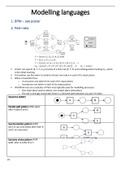Modelling languages
1. BPM – see poster
2. Petri nets
A Petri net system (P, T, F, m0) consists of a Petri net (P, T, F) and a distinguished marking m 0, which
is the initial marking.
A transition can fire when it contains at least one token in each of its input places
When a transition fires:
o It consumes one token from each of its input places
o It produces one token in each of its output places
Workflow nets are a subclass of Petri nets typically used for modelling processes:
o One input place (source place), one output place (sink place)
o The net is strongly connected: there is a directed path between any pair of nodes
Sequence pattern
Parallel split pattern (AND-split):
after A both B and C
Synchronization pattern (AND-
join): D can only follow after both B
and C are executed
Exclusive choice pattern (XOR-
split): after A either B or C
23
, Simple merge (XOR-join): D after B
or after C
Structured loop pattern: Multiple
B’s
3. Declare (declarative process modelling language)
Modeling: with symbolic arcs, e.g. Response(A,B)
Captures the notion of rules which can be satisfied in multiple ways:
o Satisfied: the constraint is satisfied
o Temporarily violated: the constraint is not fulfilled, but can still become fulfilled in the
future
o Permanently violated: the constraint is violated and cannot become fulfilled anymore
Execution: for this, regular expressions are used which can be represented as finite state machines
24




